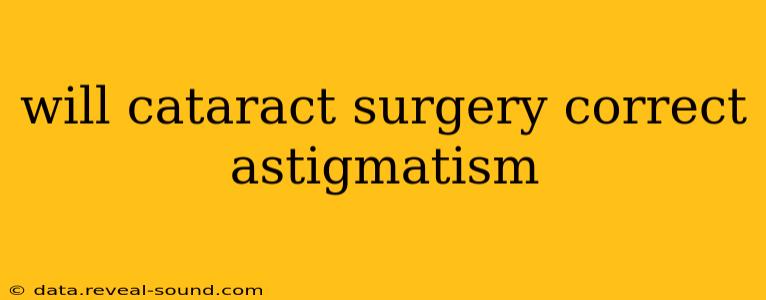Cataract surgery is a common procedure to remove a cloudy lens from the eye and replace it with an artificial intraocular lens (IOL). While primarily designed to address cataracts, the surgery presents an opportunity to correct other refractive errors, including astigmatism. But will it completely correct astigmatism? Let's delve into the details.
What is Astigmatism?
Astigmatism is a common refractive error where the eye's cornea (the clear front part of the eye) or lens is not perfectly spherical. This irregular shape causes light to focus unevenly on the retina, leading to blurry vision at all distances. Symptoms can include blurred vision, eye strain, and headaches.
Can Cataract Surgery Correct My Astigmatism?
Yes, cataract surgery can correct astigmatism, but the effectiveness depends on several factors, and it's not always a complete correction. The key is the type of IOL implanted.
Types of IOLs and Astigmatism Correction
-
Monofocal IOLs: These standard IOLs correct distance vision but don't address astigmatism. If you have astigmatism and receive a monofocal IOL, you'll likely still need glasses or contact lenses for clear vision at near and intermediate distances, and potentially for distance vision if the astigmatism is significant.
-
Toric IOLs: These specialized IOLs are designed to correct astigmatism. They have different refractive powers in different meridians, compensating for the irregular shape of the cornea. Toric IOLs offer the best chance of reducing or eliminating astigmatism during cataract surgery. They significantly improve visual acuity and reduce the need for glasses after surgery.
-
Multifocal IOLs: These IOLs correct both distance and near vision but may or may not address astigmatism. Some multifocal IOLs are available in toric versions to correct astigmatism simultaneously.
What Factors Affect Astigmatism Correction During Cataract Surgery?
The success of astigmatism correction during cataract surgery depends on several factors:
-
The severity of your astigmatism: Mild astigmatism is often correctable with a toric IOL, while significant astigmatism may require additional correction even with a toric IOL.
-
The accuracy of IOL power calculation: Precise measurements are crucial for accurate IOL implantation. Advanced technologies like optical biometry improve the accuracy of these calculations.
-
Surgical precision: The surgeon's skill and experience significantly influence the success of the procedure. An experienced surgeon is more likely to achieve accurate IOL placement and optimal astigmatism correction.
-
Post-operative healing: Proper post-operative care and healing are vital for achieving the best possible visual outcome.
Will I Still Need Glasses After Cataract Surgery With Astigmatism Correction?
Even with toric IOLs, you might still need glasses after surgery. The degree of residual astigmatism, presbyopia (age-related loss of near vision), and individual variations in healing influence the need for glasses. Some individuals might need reading glasses, while others may achieve excellent vision without any corrective lenses.
How is Astigmatism Measured Before Cataract Surgery?
Accurate pre-operative measurements are crucial for successful astigmatism correction. Your ophthalmologist will conduct a comprehensive eye examination, including:
- Refraction: Determining the refractive error of your eye.
- Keratometry: Measuring the curvature of your cornea.
- Optical biometry: Using advanced technology to measure the length and other dimensions of your eye.
Can I choose between a toric and non-toric IOL?
Yes, you will discuss your options with your ophthalmologist. They will consider your individual needs and the severity of your astigmatism to determine the most appropriate IOL for you. The choice often depends on the balance between achieving the best possible uncorrected vision and the added complexity and cost of a toric IOL.
Cataract surgery combined with a toric IOL offers an excellent opportunity to correct astigmatism and improve overall vision. However, it's crucial to have a thorough discussion with your ophthalmologist to understand the potential benefits and limitations of this approach in your specific case. Remember, every individual's experience is unique.
